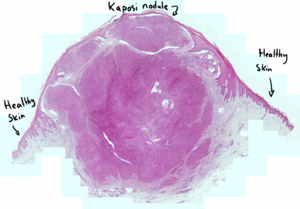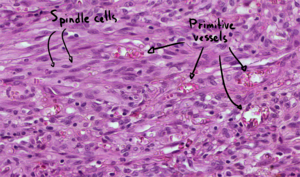43. Kaposi sarcoma
Staining: HE

Organ: Skin nodule
Description:
We can see a large skin nodule. On each side of the nodule can we see healthy, normal skin.
The skin nodule is comprised mostly of cells with elongated cytoplasm and nucleus. Between these cells are some small “cavities”, and some of them contain RBCs.
Diagnosis: Kaposi sarcoma

Etiology:
- Classic type
- Older people
- Males
- Endemic type
- Children in Africa
- Transplantation-associated type
- Transplantation-associated immunosuppression
- AIDS-related type
- AIDS
- HHV-8 virus
Theory:
Kaposi sarcoma is a malignant vascular tumor. The four types are described in the theoretical topic.
The elongated cells are called spindle cells. These spindle cells form primitive vessels amongst themselves, which can fill up with blood.
The spindle cells themselves are pleomorphic.
This is a poorly differentiated tumor, because of the pleomorphism and the fact that only primitive vessels are formed, and not mature vessels.